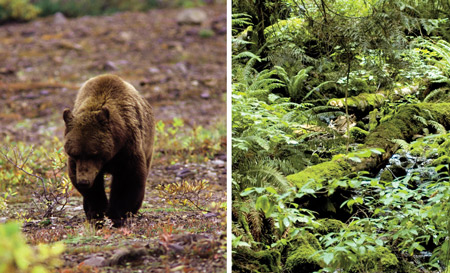Module 2 Intro
1. Module 2 Intro
1.4. Page 2
Module 2—Biosphere Equilibrium and the Impact of Humans
 Explore
Explore
 Read
Read
Begin Lesson 1 by reading pages 53 and 54 of your textbook. You will be instructed to complete the Thought Lab later on in this lesson.
Ecosystem productivity depends on many things and can be measured. Sometimes productivity can be directly or indirectly affected by human actions.
 Self-Check
Self-Check
SC 1. What is productivity?
SC 2. What is significant about algal beds and reefs? (Hint: Refer to “Figure 2.20” on page 53 of your textbook.)
SC 3. Why would the productivity of a tropical seasonal rainforest be greater than tundra? (Hint: Refer to “Figure 2.20” in your textbook.)
 Self-Check Answers
Self-Check Answers
SC 1. Productivity is the rate at which an ecosystem’s producers capture and store energy within organic compounds over a certain length of time. Productivity is measured as energy per area per year (J/m2/a) or in biomass (g/m2/a).
SC 2. Algal beds and reefs take up 0.1% of Earth’s surface area but have the highest productivity in terms of energy.
SC 3. The number of producers present in a tropical seasonal forest would be greater, as would the amount of rainfall. There would also be more heat and light available for more of the year than in the arctic.
A Closer Look at Ecosystem Productivity
Following this more in-depth look at productivity, there are Self-Check questions for you to answer.
The following are characteristics of gross productivity:
- Gross productivity is the amount of energy trapped in plant material during a specified interval at a given trophic level.
- Remember, plants trap only 2% of the solar energy around them.
- At least half of this solar energy is lost by cellular respiration as plants must also access energy for their life processes.

© Lars Johansson/iStockphoto (bear)
© David Mendel/iStockphoto (trees)
The following are characteristics of net productivity:
- Net productivity is the amount of energy trapped in plant material during a specified interval (time) at a given trophic level minus what is lost by cellular respiration of the organisms at that level (measuring biomass).
- One way to determine net productivity is to collect and weigh the plant material produced on 1 m2 of land over a given interval.
- One gram of plant material (e.g., stems and leaves), mostly carbohydrates, yields about 20 J of energy when burned or respired.
The following table shows representative values for the net productivity of a variety of ecosystems—both natural and managed. These values are only approximations and are subject to marked fluctuations because of variations in temperature, fertility, and availability of water.
Estimated Net Productivity of a Variety of Ecosystems (kJ/m2/y) |
|
temperate deciduous forest |
21 000 |
tropical rainforest |
63 000 |
tall-grass prairie |
8400 |
desert |
2100 |
coastal marsh |
50 200 |
ocean close to shore |
10 500 |
open ocean |
3300 |
clear lake |
3300 |
lake in advanced state of eutrophication |
10 500 |
 Self-Check
Self-Check
SC 4. What happens to the net productivity of an ecosystem?
SC 5. How do people directly and indirectly depend on net productivity?
SC 6. In what other ways do people depend on net productivity to meet their needs?
SC 7. How do humans reduce the net productivity of an area?
 Self-Check Answers
Self-Check Answers
SC 4. The net productivity of an ecosystem is harvested by herbivores (deer, insects). Productivity is then transferred down food chains—some is decomposed, and some is stored (growing forests, peat bogs).
SC 5. People directly depend on net productivity by eating plants. Indirectly, people eat other organisms that consume plants or other animal products.
SC 6. For example, people use plant materials for construction, fuel, and for clothing.
SC 7. Humans reduce the net productivity of an area by clearcutting to build roads and houses and to develop agriculture and industry.